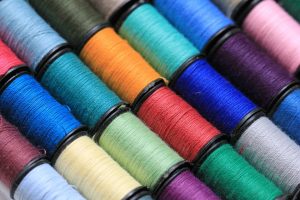Denier and yarn count: What do they mean?
When dealing with fabrics and yarns, we often see words related to thickness, such as count or denier.
There are several units that express the thickness of yarn, but what is the difference between them?
In this article, we would like to take a closer look at how yarn thickness is expressed.

Yarn thickness is an important factor related to the texture of textiles. However, the cross section of yarn is not uniform and it is difficult to measure the diameter, so the weight and length of yarn are indirectly expressed.
Yarn thickness is often indicated by denier or count.
You may have heard of denier for tights and stockings, and count for the thickness of denim.
Denier
Denier is a unit used for filament yarn (continuous long fiber) and refers to the weight per 9000m. 1g in 9000m is 1 denier, 50g is 50 denier.
The higher the denier number, the thicker the yarn.
Continuous long fiber
A long continuous fiber. Silk, which is composed of fibers as long as 1,000 meters, is classified as a filament.
Chemical fibers are man-made fibers, so both continuous filaments and short fibers can be made.
Yarn count
Count is a unit used for yarn made by spinning short fibers*.
The numerical value is obtained by measuring “how much length there is for a certain weight “.
Threads weighing 1 pound and having a length of 840 yards are one count, and the higher the number, the finer the thread.
However, even if the number of filament threads and the number of spun threads are the same, they cannot be simply compared because the standards are different.
Also, even if the number of counts is the same, such as cotton, linen, and wool, the thickness will differ depending on the material.
Short fiber
Short fibers. It is also called “staple fiber”, “staple”’.
Cotton, linen, and wool are short fibers with a fiber length ranging from several centimeters to several tens of centimeters at the longest.
What is “denier,” which we hear a lot about these days?
Recently, tex (tex) and dtex (denier) are often used in accordance with International Organization for Standardization (ISO) standards.
These are units that can be used for all yarns: 1 tex is 1 g per 1000 m, and 1 dtex is 1 g per 10000 m. The higher the number, the thicker the yarn.
What about the thickness of natural fibers?
Each natural fiber has its own specific thickness. The thickest natural fiber is ramie, followed by wool, then flax (linen), cotton, and silk.
The finer the fiber, the denser and thinner the fabric. Conversely, the thicker the fiber, the easier it is to make breathable fabrics.
Conclusion
The thickness of yarn has various names depending on the type of fiber. Even with the same number, denier, yarn count, and denier are completely different thicknesses, so you have to be careful about the units. It is also important to change the material and thickness of the yarn depending on the fabric and sewing method.
To find fabric with suitable thickness for your design, please visit ApparelX’s fabric list .



